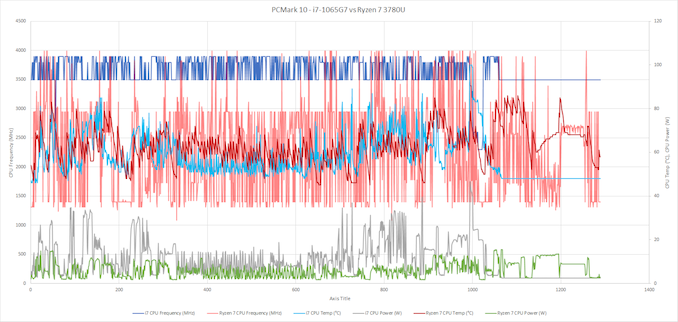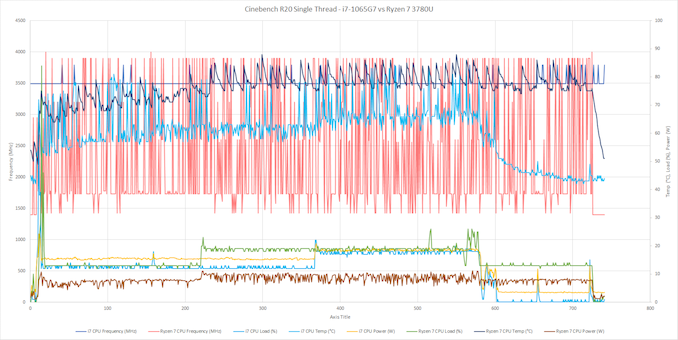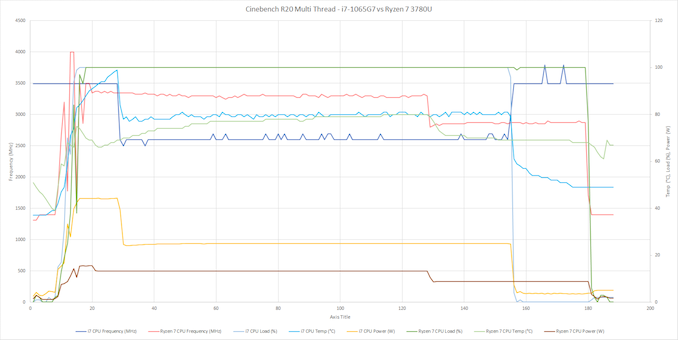The Microsoft Surface Laptop 3 Showdown: AMD's Ryzen Picasso vs. Intel's Ice Lake
by Brett Howse & Andrei Frumusanu on December 13, 2019 8:30 AM ESTBenchmark Analysis: Boost Behavior
Let’s dig into some of the testing to see how the systems responded during the benchmarks. We re-ran several of the tests while simultaneously monitoring the processor frequency, temperature, and power. Unfortunately for our comparison, the power polling results provided by our monitoring tools don’t seem to monitor the same power draw. The Intel power numbers are for the SoC package, but the AMD power numbers appear to be just the CPU cores, which is an unfortunate byproduct of testing two different platforms.
PCMark 10
PCMark 10 is a benchmark platform that attempts to simulate real-world tasks by running a variety of workflow, and the results were perhaps the most interesting of any of the benchmarks. There is a major discrepancy in how the AMD CPU behaved compared to the Intel. The Ice Lake platform kept the CPU frequency at a minimum of 3.5 GHz, with bursts to 3.9 GHz when under load. The Picasso processor was very aggressively switching from low frequency to high frequency, and was rarely indicating that it was over 3.0 GHz, but clearly demonstrating its higher peak frequency of 4.0 GHz in several locations. Both systems were fairly even in terms of CPU temperature, and Intel’s aggressive turbo levels were evident with peak power levels of 40 Watts for brief moments. The Ice Lake platform finished the benchmark about 200 seconds quicker than the Picasso system.
Cinebench R20 Single-Thread
We see somewhat similar results when only a single CPU core is loaded with the Picasso CPU frequency varying quite a bit. There’s also an average higher temperature on the AMD platform during this workload, and once again Ice Lake finishes the rendering quite a bit sooner thanks to its stronger CPU cores.
Cinebench R20 Multi-Thread
With all cores loaded the graph is considerably altered. Here the AMD processor is able to maintain a much higher frequency across its cores for much longer, while Intel's chip is only able to maintain 3.5 GHz for about 30 seconds before it runs out of headroom, dropping the cores down to around 2.6 GHz. But despite the lower frequency, the much higher IPC on Sunny Cove allows the Ice Lake platform to finish quite a bit sooner.













174 Comments
View All Comments
MBarton - Monday, December 30, 2019 - link
Agreed. Even the outlook for 2020 server ICL has vanished from Intel's presentations. If they can't get working server parts out, there definitely won't be a 10nm desktop part in 2020.deil - Monday, December 16, 2019 - link
I just wonder why...16 GB Dual-Channel DDR4-2400 16 GB Dual-Channel LPDDR4X-3733
AMD gains A LOT from faster ram, what they get? cheappest....
Brett Howse - Monday, December 16, 2019 - link
That's all that Picasso supportseastcoast_pete - Wednesday, December 18, 2019 - link
That is why I am more upset with AMD not putting their best foot forward on mobile. A mobile APU based on Zen2 in 7 nm with Navi-based graphics and an LPDDR4 or LPDDR5 capable memory controller would have given Intel's Ice Lake a real challenge. Instead, AMD is a full generation behind. Ironic, as it's the other way around for desktops.MBarton - Monday, December 30, 2019 - link
Why would a cash-strapped AMD "put their best foot forward" in the mobile segment. It's the lowest profit market of the three. They need profit margins and server/HEDT are FAR more profitable than mobile.MutualCore - Monday, December 16, 2019 - link
Why nothing about SSD performance? This is a critical point for people that need to copy large amounts of data.derstef - Wednesday, December 18, 2019 - link
"DDR4-2400" vs "LPDDR4X-3733" ... fair comparision on the GPU side of things? I dont think so.Butterfish - Friday, December 20, 2019 - link
Your argument is irrelevant. Both are using the best possible RAM they supported. It is AMD’s fault to recycle old chip with outdated spec. We are comparing mobile platform (laptop), not desktop. Everything is highly integrated with CPU influences GPU performance. As both laptops are house in the same cooling solution it is a fair comparison to see which platform is faster in various task.maroon1 - Sunday, January 12, 2020 - link
AMD does not support LPDDR4XAnsley11 - Wednesday, December 18, 2019 - link
$2000, you've got to be kidding me! Why would anyone waste there money on these? I can get a $1000 desktop then can blow these away, and get a couple hundred dollar tablet to do the tablet stuff. Heck, I could probably get both for under $1000 if I shop around and am smart with my choices. People waste FAR too much money on unnecessary tech.